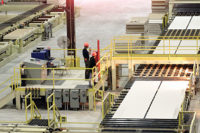For as long as I am permitted to hang around in the gypsum industry, I doubt I will see anything like the enormous salad bowl that a contractor created using metal studs and gypsum board. Simultaneously impressive and bizarre, the bowl was over six feet in height and functioned as the centerpiece of a restaurant where it was filled with mock vegetables fashioned from cloth and rigid backing.
Somewhat less unique, but no less impressive, are the floating, angular walls and ceilings in a Philadelphia sneaker store that are shown in the photo above. Full of crisp, sharp angles, the installation reflects the abilities of a skilled framer.
In both installations, the attachment grounds, specifically the metal studs, were intentionally cut, bent, and rotated during installation to create curved and angular surfaces. Hopefully the wallboard applicator knew what was coming when he or she signed on for the job.
Unfortunately, as many applicators can attest, it’s more the norm for cut, bent, or curved framing members to be a last minute jobsite surprise. Occasionally the problem can be attributed to poor framing quality control, but generally it’s part of what happens on a jobsite when installed materials get damaged during the course of construction. Such situations rarely end well. Once the board is installed, the questionable framing is concealed and if the visible surface is unacceptable the applicator gets all the blame.
Therefore, the prudent wallboard applicator closely inspects the framing members or attachment grounds prior to beginning the application process. While no defined regimen exists to guide the inspection process, a good starting point is to determine if the attachment surfaces are plumb or level. No amount of wallboard can square an out-of-plumb wall or correct an out of level ceiling.
PLUMB TOLERANCE
Project specifications occasionally contain a defined plumb tolerance for walls—plumb within 1/4 of an inch in 10 feet is a common benchmark—but none of the code-referenced gypsum board or stud application documents contain a specific numerical tolerance to define whether a planar surface is in or out of plumb. Lacking a specific tolerance for plumb construction, common sense needs to prevail. The best method is obvious: assess the planar surface with simple tools like levels and measuring tapes, if it appears out of plumb, it should be corrected. Ceilings also need to be level based on an agreed benchmark point. A quick check of any framed surface is worth the time spent.
Transition points between adjacent wall or ceiling sections should also be examined. Unless the wall or ceiling is intentionally designed to replicate a double helix DNA model, adjacent or transitioning sections should be in plane. GA-216, Application and Finishing of Gypsum Panel Products, Section 4.1.8., requires that the “attachment surface of any framing or furring member shall not vary more than 1/8 inch from the plane of the faces of adjacent framing or furring members.” If the end studs on adjacent framed sections are out of alignment, there is a good possibility that one or both of the sections are also out of level, or are not plumb.
Once it has been established that the framed surface is plumb or level, individual framing members should be examined for interval spacing, alignment, and quality. Interval spacing is a function of multiple variables, including, but not limited to, the direction in which the board is oriented to the framing members, and the thickness of the board. Studs spaced too far apart will not adequately support the attached board and can lead to finished surfaces that appear wavy or bowed. The tables and text in an application standard such as GA-216 should be referenced for spacing information.
IN LINE
Studs should be in line with the plane of the framed surface and spaced equally from adjacent members along their entire length. An individual stud can seat properly at a runner or plate, yet be in violation of the “1/8 inch” requirement at the mid-point of the wall or ceiling if it is damaged, bent, or exhibits poor quality. If a stud protrudes more than “1/8 of an inch from the plane of the face of the adjacent framing or furring members” (GA-216), it should be replaced or repaired.
Particular care should be given to inspecting the junction point at which the studs are seated into runners or affixed to wood plates. Metal studs snap into manufactured runners, so installed metal studs will probably be correctly aligned if the runners are undamaged, properly lined up, and exhibit the same manufactured dimension as the studs. Wood studs may require a somewhat closer inspection because they are often nailed to plates that can be knocked slightly out of line when the wall or ceiling is framed. An extra whack on a framing nail can create a lip between the stud and the plate that is difficult to conceal with wallboard.
The overall quality of framing members is addressed in Section 4 of GA-216. Wood framing members are required to be “straight and true.” Straight means what it says: wood studs should not be bent or unintentionally curved. True is generally interpreted to mean non-deformed. Studs shouldn’t contain gouged out sections or be hacked to shreds by other trades. Metal studs also should be “straight” and not “bent, damaged, or twisted.”
In addition, product standards referenced in GA-216 provide additional back-up for defining the quality of metal and wood studs. Wood studs are required to comply with the American Softwood Lumber Standard, and metal studs are required to comply with ASTM standards: specifically, ASTM C 645 for nonstructural studs, and ASTM C 955 for thicker steel studs. A metal stud, for example, that arrives on the jobsite full of extraneous holes and gouges, likely won’t meet the manufacturing standard. Neither will a wood stud that is pitted and cracked. In either instance, the substandard framing member should be viewed with skepticism.
The overarching point is quite simple, if the grounds to which you attach the board are not properly installed, the overall gypsum board application runs the risk of being judged as inadequate. Don’t take the risk that might come from trying to fix damaged work. Inspect the surface to which you are applying board before you begin the application process. If it appears to be problematic, take action before you begin the board application process. W&C







